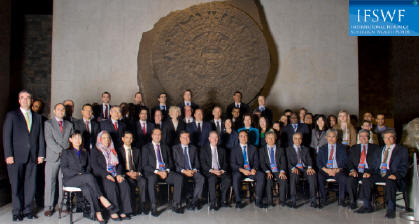
Members of the International Forum on Sovereign Wealth Funds gathered for their 2012 annual meeting in Mexico City last September. The group will meet again in Oslo in early October.
Sovereign wealth funds (SWFs) have made progress in improving their accountability and transparency over the last five years, but more can and should be done. That’s the assessment of Dr. Edwin M. (Ted) Truman, a senior fellow at the Peterson Institute for International Economics and former senior Treasury and Federal Reserve official. Truman’s pioneering work on SWF best practices helped shape the dialogue that preceded a working group of 23 countries endorsing voluntary guidelines for SWF operations, the Santiago Principles, in October 2008. In a recent interview with this blog, Truman shared his appraisal of SWF performance in advance of the anticipated release this summer of a survey of member practices by the International Forum on Sovereign Wealth Funds, as the original working group is now called.
Markets, elected officials, and the media all were intently focused on SWFs in 2007, when Truman proposed a scoreboard for assessing the state-sponsored funds on 33 criteria grouped into four categories: structure, governance, accountability and transparency, and behavior. Truman explained that at the time, financial markets’ and policy makers’ concerns about the SWFs “were driven, first, by the fact that these funds were viewed as new by most people. Even though a few had been started years before, the term ‘sovereign wealth fund’ did not exist until 2005, and now the number of funds was growing rapidly. Second, there were concerns about how they would be managed both from a financial standpoint as well as from a strategic standpoint,” as China, Russia, Gulf region states and others had billions to invest from the proceeds of oil and natural gas sales, foreign exchange reserves, fiscal surpluses, or other sources.
Against that backdrop, Truman followed the 2007 publication of his scoreboard with an April 2008 “blueprint” for SWF best practices that measured 34 SWFs by the criteria he previously had proposed – and found that as a group they trailed behind the average scores for 10 state-sponsored pension funds he had examined for comparative purposes. Out of a possible 100 points in each category, the SWFs averaged a 68 for structure, 42 for governance, 44 for accountability and transparency, and 25 for behavior, for an overall average score of 46.
Five months later, the representatives of 23 countries – including the United States, China, Russia, Iran, Saudi Arabia, Norway, Singapore, the United Arab Emirates, Canada and Libya – met in Santiago, Chile at the encouragement of the International Monetary Fund (IMF) and fashioned 24 Generally Accepted Principles and Practices (GAPP) that they approved the following month and that became known as the Santiago Principles. Among other things, those principles call for public disclosure of a fund’s purpose; funding, withdrawal, and spending policies; governance framework and objectives; and the manner in which the management is operationally independent of the owner. While the Principles call for annual audits of a fund’s operations and financial statements, they stop short of endorsing public disclosure of audit results, saying only that funds should comply with the “disclosure requirements of the countries in which they operate” and, more vaguely, that “relevant financial information regarding the SWF should be disclosed to demonstrate its economic and financial orientation, so as to contribute to stability in international financial markets and enhance trust in recipient countries.”
In Truman’s view, the principles “are reasonably good measures, although they tend to mush together some of the individual elements that would provide more clarity” about fund operations. In particular, he sees the principles as lacking in that they don’t call upon participants to disclose the size of their funds and because they are not more specific about what information a fund should disclose.
Truman says that the funds on the whole have enhanced their accountability and transparency in the five years since promulgation of the Santiago Principles, although a July 2011 International Forum Report on members’ experiences in implementing the principles “somewhat exaggerated the level of compliance, in my opinion.”
Despite the overall favorable trend, Truman sees two major issues looming for the International Forum and its members. First, he explains that three founding members of the group – Iran, Libya and Equatorial Guinea – did not participate in the survey on implementation of the Santiago Principles and, as far as we know, have not provided other evidence of adopting those principles. Second, the forum has not expanded its membership in recent years, as at least a half dozen major funds in the Middle East and Southeast Asia have chosen, at least thus far, not to join the group and subscribe to its voluntary principles.
The concerns and even trepidation that swirled around SWFs when Truman published his scoreboard in 2007 have abated in the intervening years, a trend that he attributes to the funds “being de-mystified somewhat as people have learned more about them.” Nonetheless, Truman notes that those years also have seen several nations pass legislation governing foreign investment in general and state-sponsored foreign investment in particular, while the citizens of many countries that sponsor SWFs have begun demanding greater transparency regarding fund operations. (Truman explores a number of trends affecting the funds in his 2010 book, Sovereign Wealth Funds: Threat or Salvation?, published by the Peterson Institute for International Economics.) Meanwhile, the market clout of the funds has only grown. Despite taking a hit along with funds of all types during the global financial crisis, the Sovereign Wealth Fund Institute, a private research organization, estimates that 68 SWFs today have total assets of $5.4 trillion.
As the fifth anniversary of adoption of the Santiago Principles approaches, Truman, the capital markets, and policy makers and citizens both in countries sponsoring SWFs and receiving fund investments are sure to give close attention to the International Forum’s next report on members’ experience implementing those principles.